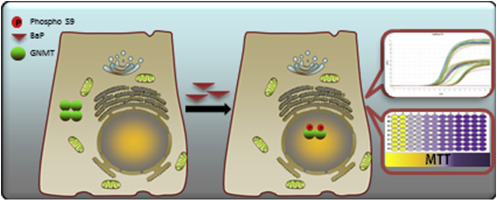当前位置:
X-MOL 学术
›
J. Food Drug Anal.
›
论文详情
Our official English website, www.x-mol.net, welcomes your
feedback! (Note: you will need to create a separate account there.)
Utilizing proteomic approach to identify nuclear translocation related serine kinase phosphorylation site of GNMT as downstream effector for benzo[a]pyrene
Journal of Food and Drug Analysis ( IF 2.6 ) Pub Date : 2019-04-01 , DOI: 10.1016/j.jfda.2018.12.007 Ming-Hui Yang, Chen-Chung Liao, Jung-Hsien Hung, Xiu-Ting Lai, Chia-Hung Yen, Yi-Ming Arthur Chen
Journal of Food and Drug Analysis ( IF 2.6 ) Pub Date : 2019-04-01 , DOI: 10.1016/j.jfda.2018.12.007 Ming-Hui Yang, Chen-Chung Liao, Jung-Hsien Hung, Xiu-Ting Lai, Chia-Hung Yen, Yi-Ming Arthur Chen

|
Glycine N-methyltransferase (GNMT) protein is highly expressed in certain tissues, such as liver, pancreas, and prostate. GNMT serves multiple roles which include a methyl group transfer enzyme and a liver tumor suppressor. Benzo(a)pyrene (BaP), a family member of polycyclic aromatic hydrocarbon (PAH), is a known environmental carcinogen found in coal tar, tobacco smoke, barbecued food and incomplete combustion of auto fuel. BaP recruits cytochrome P450 to transform itself into benzo(a)pyrene-7,8-diol-9,10-epoxide (B(a)PDE), which covalently interacts with DNA causing tumorigenesis. BaP can be detoxified through GNMT and induces GNMT translocation into the cellular nucleus. GNMT translocation is accompanied by phosphorylation, but the role of phosphorylation in GNMT remains to be explored. Using liquid chromatography coupled with tandem mass spectrometry, this study identified serine 9 of GNMT as the phosphorylation site upon BaP treatment. When serine 9 was mutated and lost the capability to be phosphorylated, the occurrence of BaP-induced GNMT nuclear translocation was dramatically decreased. Also, this mutant from of GNMT lost the ability of phosphorylation and increased cytochrome P450 1A1 (Cyp1a) expression upon BaP treatment. In addition, protein kinase C (PKC) and c-Jun NH2-terminal kinase (JNK) may be required for such phosphorylation. Further characterization of phosphorylated GNMT for its link to BaP may bring new insights into chemical detoxification.
中文翻译:

利用蛋白质组学方法鉴定 GNMT 的核易位相关丝氨酸激酶磷酸化位点作为苯并[a]芘的下游效应物
甘氨酸 N-甲基转移酶 (GNMT) 蛋白在某些组织中高度表达,例如肝脏、胰腺和前列腺。GNMT 发挥多种作用,包括甲基转移酶和肝肿瘤抑制因子。苯并(a)芘(BaP)是多环芳烃(PAH)家族成员,是已知的环境致癌物,存在于煤焦油、烟草烟雾、烧烤食品和汽车燃料不完全燃烧中。BaP 招募细胞色素 P450 将自身转化为 benzo(a)pyrene-7,8-diol-9,10-epoxide (B(a)PDE),它与 DNA 共价相互作用导致肿瘤发生。BaP 可通过 GNMT 解毒并诱导 GNMT 易位进入细胞核。GNMT 易位伴随着磷酸化,但磷酸化在 GNMT 中的作用仍有待探索。使用液相色谱与串联质谱联用,本研究确定 GNMT 的丝氨酸 9 是 BaP 处理后的磷酸化位点。当丝氨酸 9 发生突变并失去被磷酸化的能力时,BaP 诱导的 GNMT 核易位的发生率显着降低。此外,这种来自 GNMT 的突变体在 BaP 处理后失去了磷酸化能力并增加了细胞色素 P450 1A1 (Cyp1a) 的表达。此外,这种磷酸化可能需要蛋白激酶 C (PKC) 和 c-Jun NH2-末端激酶 (JNK)。磷酸化 GNMT 与 BaP 的联系的进一步表征可能为化学解毒带来新的见解。BaP 诱导的 GNMT 核转位的发生率显着降低。此外,这种来自 GNMT 的突变体在 BaP 处理后失去了磷酸化能力并增加了细胞色素 P450 1A1 (Cyp1a) 的表达。此外,这种磷酸化可能需要蛋白激酶 C (PKC) 和 c-Jun NH2-末端激酶 (JNK)。磷酸化 GNMT 与 BaP 的联系的进一步表征可能为化学解毒带来新的见解。BaP 诱导的 GNMT 核转位的发生率显着降低。此外,这种来自 GNMT 的突变体在 BaP 处理后失去了磷酸化能力并增加了细胞色素 P450 1A1 (Cyp1a) 的表达。此外,这种磷酸化可能需要蛋白激酶 C (PKC) 和 c-Jun NH2-末端激酶 (JNK)。磷酸化 GNMT 与 BaP 的联系的进一步表征可能为化学解毒带来新的见解。
更新日期:2019-04-01
中文翻译:

利用蛋白质组学方法鉴定 GNMT 的核易位相关丝氨酸激酶磷酸化位点作为苯并[a]芘的下游效应物
甘氨酸 N-甲基转移酶 (GNMT) 蛋白在某些组织中高度表达,例如肝脏、胰腺和前列腺。GNMT 发挥多种作用,包括甲基转移酶和肝肿瘤抑制因子。苯并(a)芘(BaP)是多环芳烃(PAH)家族成员,是已知的环境致癌物,存在于煤焦油、烟草烟雾、烧烤食品和汽车燃料不完全燃烧中。BaP 招募细胞色素 P450 将自身转化为 benzo(a)pyrene-7,8-diol-9,10-epoxide (B(a)PDE),它与 DNA 共价相互作用导致肿瘤发生。BaP 可通过 GNMT 解毒并诱导 GNMT 易位进入细胞核。GNMT 易位伴随着磷酸化,但磷酸化在 GNMT 中的作用仍有待探索。使用液相色谱与串联质谱联用,本研究确定 GNMT 的丝氨酸 9 是 BaP 处理后的磷酸化位点。当丝氨酸 9 发生突变并失去被磷酸化的能力时,BaP 诱导的 GNMT 核易位的发生率显着降低。此外,这种来自 GNMT 的突变体在 BaP 处理后失去了磷酸化能力并增加了细胞色素 P450 1A1 (Cyp1a) 的表达。此外,这种磷酸化可能需要蛋白激酶 C (PKC) 和 c-Jun NH2-末端激酶 (JNK)。磷酸化 GNMT 与 BaP 的联系的进一步表征可能为化学解毒带来新的见解。BaP 诱导的 GNMT 核转位的发生率显着降低。此外,这种来自 GNMT 的突变体在 BaP 处理后失去了磷酸化能力并增加了细胞色素 P450 1A1 (Cyp1a) 的表达。此外,这种磷酸化可能需要蛋白激酶 C (PKC) 和 c-Jun NH2-末端激酶 (JNK)。磷酸化 GNMT 与 BaP 的联系的进一步表征可能为化学解毒带来新的见解。BaP 诱导的 GNMT 核转位的发生率显着降低。此外,这种来自 GNMT 的突变体在 BaP 处理后失去了磷酸化能力并增加了细胞色素 P450 1A1 (Cyp1a) 的表达。此外,这种磷酸化可能需要蛋白激酶 C (PKC) 和 c-Jun NH2-末端激酶 (JNK)。磷酸化 GNMT 与 BaP 的联系的进一步表征可能为化学解毒带来新的见解。











































 京公网安备 11010802027423号
京公网安备 11010802027423号